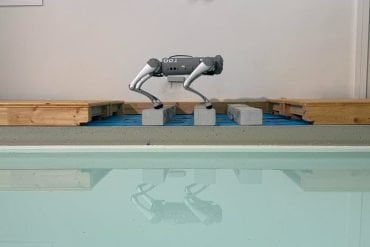Summary: Study reveals C3, which can cause damage in some eye diseases, may help to slow the progression of retinitis pigmentosa.
Source: NIH/NEI
A new study shows that the complement system, part of the innate immune system, plays a protective role to slow retinal degeneration in a mouse model of retinitis pigmentosa, an inherited eye disease. This surprising discovery contradicts previous studies of other eye diseases suggesting that the complement system worsens retinal degeneration. The research was performed by scientists at the National Eye Institute (NEI), part of the National Institutes of Health, and appears in the Journal of Experimental Medicine.
Retinitis pigmentosa is an incurable and unpreventable blinding eye disease that affects 1 in 4,000 people.
“Much research is devoted to studying therapies that attempt to alter the immune system’s role in inherited diseases such as retinitis pigmentosa because such treatments would have broad applicability, regardless of a patient’s causative mutation,” said the study’s principal investigator Wai T Wong, M.D., Ph.D., chief the Neuron-Glia Interactions in Retinal Disease Section at NEI.
In previous studies, activation of the complement system, which mediates some aspects of inflammation, worsens damage in age-related macular degeneration (AMD), a leading cause of blindness in people age 65 years and older.
“The current study involving retinitis pigmentosa underscores the notion that the complement system may in fact exacerbate or curb retinal degeneration depending on the context. Appreciating this complexity is important for guiding the development of therapies that target the complement immune system to treat degenerative diseases of the retina,” Dr. Wong said.
Sean Silverman, Ph.D., an NEI postdoctoral researcher in Dr. Wong’s lab and the lead author on the study, and colleagues monitored the genetic expression of the complement system in a transgenic mouse model of retinitis pigmentosa. They found that upregulation of complement expression and activation coincided with the onset of photoreceptor degeneration. What’s more, this upregulation occurs in the exact location of the degeneration.
“Having found complement at the scene of the crime, we then wanted to know whether it was helping or hurting the degenerative process,” Dr. Wong said.
Using the retinitis pigmentosa mouse model, the researchers examined the role of C3 and CR3, the central component of complement and its receptor, by comparing mice with genetically ablated C3 or CR3 to mice with normal expression. They found that the absence of C3 or CR3 made degeneration worse. Rod photoreceptors, the light-sensing cells that die off first in retinitis pigmentosa, were precipitously lost along with a surge in the expression of neurotoxic inflammatory cytokines.
They pieced together that C3 gets secreted by microglia, trash-collecting cells that in a healthy retina clear away dead cells by phagocytosis to keep the tissue working properly. Once secreted, C3 lands on dead photoreceptors labeling them for destruction and removal. The receptor, CR3, recognizes the C3 markers and conveys the information to microglia. “Breakdown of this C3-CR3 interaction results in a decreased ability of microglia to phagocytose dead photoreceptors, which then accumulate in the retina, stimulating greater inflammation and degeneration,” Dr. Wong said. “Degeneration accelerates pretty quickly.”
When placed alongside each other in a dish, microglia from C3- or CR3-ablated retinas turned out to be toxic to photoreceptors.

Taken together, the results show that in the context of retinitis pigmentosa, complement activation is actually helpful for clearing away dead cells and maintaining a state of homeostasis, a physiological balance, in the retina.
However, in the context of AMD, harmful effects observed from complement activation have spurred clinical trials testing complement inhibitors. “Our findings suggest that this approach may be appropriate for some disease scenarios, but may induce complex responses in other disease scenarios by inhibiting helpful and homeostatic functions of inflammation,” Dr. Wong said.
Further research is needed to complete the picture of how, and under what circumstances, complement activation has beneficial or harmful effects on photoreceptors and disease progression.
Source:
NIH/NEI
Media Contacts:
Kathryn DeMott – NIH/NEI
Image Source:
The image is credited to Wai Wong, M.D., Ph.D..
Original Research: Closed access
“C3- and CR3-dependent microglial clearance protects photoreceptors in retinitis pigmentosa”.
Sean M. Silverman, Wenxin Ma, Xu Wang, Lian Zhao, Wai T. Wong.
Journal of Experimental Medicine. doi:10.1084/jem.20190009
Abstract
C3- and CR3-dependent microglial clearance protects photoreceptors in retinitis pigmentosa
Complement activation has been implicated as contributing to neurodegeneration in retinal and brain pathologies, but its role in retinitis pigmentosa (RP), an inherited and largely incurable photoreceptor degenerative disease, is unclear. We found that multiple complement components were markedly up-regulated in retinas with human RP and the rd10 mouse model, coinciding spatiotemporally with photoreceptor degeneration, with increased C3 expression and activation localizing to activated retinal microglia. Genetic ablation of C3 accelerated structural and functional photoreceptor degeneration and altered retinal inflammatory gene expression. These phenotypes were recapitulated by genetic deletion of CR3, a microglia-expressed receptor for the C3 activation product iC3b, implicating C3-CR3 signaling as a regulator of microglia–photoreceptor interactions. Deficiency of C3 or CR3 decreased microglial phagocytosis of apoptotic photoreceptors and increased microglial neurotoxicity to photoreceptors, demonstrating a novel adaptive role for complement-mediated microglial clearance of apoptotic photoreceptors in RP. These homeostatic neuroinflammatory mechanisms are relevant to the design and interpretation of immunomodulatory therapeutic approaches to retinal degenerative disease.






